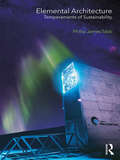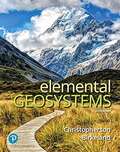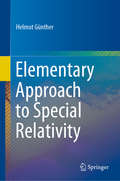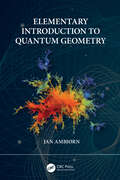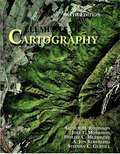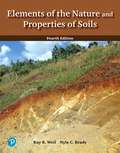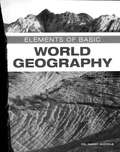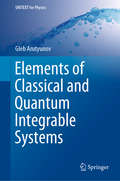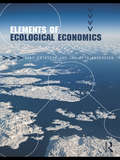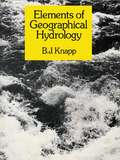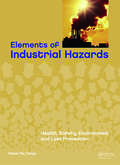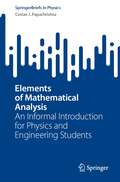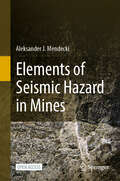- Table View
- List View
Elemental Analysis of Airborne Particles
by Sheldon Landsberger Marsha CreatchmanAn increased standard of living in developed and developing countries has brought about a distinct rise in pollution. The problem of air pollution has specifically increased the public's awareness of the environmental and health-related consequences resulting from modern day industrial technology. This detailed collection of works devoted to the most popular methods in elemental analysis of airborne particles offers investigators a comprehensive book on the most common laboratory analytical methods currently used in trace element analysis. Discussed are atomic absorption spectrometry, inductively coupled plasma, atomic emission, particle induced gamma ray analysis, particle elastic scattering and Rutherford backscattering, and neutron activation analysis. Specific sections on quality assurance/quality control and source receptor modeling have also been included.
Elemental Architecture: Temperaments of Sustainability
by Phillip James TabbElemental Architecture presents a new and refreshing approach to sustainable architectural practice. Going beyond the standard performance-based and quantitative sustainable measures, it incorporates a broader framework of considerations, including the more poetic and noetic possibilities of environmental design. The book is structured around the ancient Greek and medieval alchemists’ system of the Five Temperaments: fire, earth, air, water, and ether. Phillip James Tabb examines how these elements produce both positive and negative environmental forces which have an impact on architectural design – from drinking water and fresh air to torrential floods and tornados. He shows how responding to or enhancing these forces can help us to create a more sustainable, healthy, and purposeful architecture. To illustrate this, each chapter draws on seminal contemporary works of architecture, from Peter Zumthor’s Bruder-Klaus Field Chapel to Frank Lloyd Wright’s masterpiece at Fallingwater. These examples are accompanied by over a hundred high-quality illustrations. Expanding the discussion of sustainability to include phenomenological as well as qualitative considerations, Elemental Architecture is ideal for students and researchers with an interest in sustainable architecture and architectural theory.
Elemental Ecocriticism: Thinking with Earth, Air, Water, and Fire
by Jeffrey Jerome Cohen Lowell DuckertFor centuries it was believed that all matter was composed of four elements: earth, air, water, and fire in promiscuous combination, bound by love and pulled apart by strife. Elemental theory offered a mode of understanding materiality that did not center the cosmos around the human. Outgrown as a science, the elements are now what we build our houses against. Their renunciation has fostered only estrangement from the material world. The essays collected in Elemental Ecocriticism show how elemental materiality precipitates new engagements with the ecological. Here the classical elements reveal the vitality of supposedly inert substances (mud, water, earth, air), chemical processes (fire), and natural phenomena, as well as the promise in the abandoned and the unreal (ether, phlogiston, spontaneous generation). Decentering the human, this volume provides important correctives to the idea of the material world as mere resource. Three response essays meditate on the connections of this collaborative project to the framing of modern-day ecological concerns. A renewed intimacy with the elemental holds the potential of a more dynamic environmental ethics and the possibility of a reinvigorated materialism.
Elemental Geosystems
by Robert Christopherson Ginger Birkeland Charles Thomsen Stephen CunhaFor introductory physical geography courses. <p><p>Explore Earth’s dynamic, changing systems <p><p>Among the most highly regarded textbooks in physical geography, Robert Christopherson’s best-selling Elemental Geosystems retains its unparalleled currency, accuracy, rich integration of climate change science, and dynamic multimedia program. <p><p>Organized around the natural flow of energy, materials, and information, subjects are presented in the same sequence in which they occur in nature―an organic, holistic approach that is unique in this discipline. The 9th Edition features updated content and new Mastering Geography activities, while also incorporating new visual media, active learning activities, and visual tools to help student engagement and mastery.
Elemental: How Five Elements Changed Earth’s Past and Will Shape Our Future
by Stephen PorderAn ecologist explores how life itself shapes Earth using the elemental constituents we all shareIt is rare for life to change Earth, yet three organisms have profoundly transformed our planet over the long course of its history. Elemental reveals how microbes, plants, and people used the fundamental building blocks of life to alter the climate, and with it, the trajectory of life on Earth in the past, present, and future.Taking readers from the deep geologic past to our current era of human dominance, Stephen Porder focuses on five of life&’s essential elements—hydrogen, oxygen, carbon, nitrogen, and phosphorus. He describes how single-celled cyanobacteria and plants harnessed them to wildly proliferate across the oceans and the land, only to eventually precipitate environmental catastrophes. He then brings us to the present, and shows how these elements underpin the success of human civilization, and how their mismanagement threatens similarly catastrophic unintended consequences. But, Porder argues, if we can learn from our world-changing predecessors, we can construct a more sustainable future.Blending conversational storytelling with the latest science, Porder takes us deep into the Amazon, across fresh lava flows in Hawaii, and to the cornfields of the American Midwest to illuminate a potential path to sustainability, informed by the constraints imposed by life&’s essential elements and the four-billion-year history of life on Earth.
Elementary Approach to Special Relativity
by Helmut GüntherThis book presents an alternative representation of Einstein's Special Theory of Relativity, which makes Special Relativity much more comprehensible. Moreover, one will come across a fundamental relationship between the Special Theory of Relativity and the mechanics of space lattice. In all previous formulations, the Einsteinian special principle of relativity, in one or the other form is used as the starting point for Special Relativity. In correspondence to this principle, one takes it as granted apriori, that all observers independent of their uniform motion to each other measure one and the same propagation velocity of a light signal. This book is thought of as a lecture for physicists, mathematicians and computer scientists and concentrates on the students of these fields. The book should reach a broad circle of interested readers from the fields of natural sciences and philosophy and provide and invigorating experience for engineers.
Elementary Introduction to Quantum Geometry
by Jan AmbjornThis graduate textbook provides an introduction to quantum gravity, when spacetime is two-dimensional. The quantization of gravity is the main missing piece of theoretical physics, but in two dimensions it can be done explicitly with elementary mathematical tools, but it still has most of the conceptional riddles present in higher dimensional (not yet known) quantum gravity. It provides an introduction to a very interdisciplinary field, uniting physics (quantum geometry) and mathematics (combinatorics) in a non-technical way, requiring no prior knowledge of quantum field theory or general relativity. Using the path integral, the chapters provide self-contained descriptions of random walks, random trees and random surfaces as statistical systems where the free relativistic particle, the relativistic bosonic string and two-dimensional quantum gravity are obtained as scaling limits at phase transition points of these statistical systems. The geometric nature of the theories allows one to perform the path integral by counting geometries. In this way the quantization of geometry becomes closely linked to the mathematical fields of combinatorics and probability theory. By counting the geometries, it is shown that the two-dimensional quantum world is fractal at all scales unless one imposes restrictions on the geometries. It is also discussed in simple terms how quantum geometry and quantum matter can interact strongly and change the properties both of the geometries and of the matter systems. It requires only basic undergraduate knowledge of classical mechanics, statistical mechanics and quantum mechanics, as well as some basic knowledge of mathematics at undergraduate level. It will be an ideal textbook for graduate students in theoretical and statistical physics and mathematics studying quantum gravity and quantum geometry. Key features: Presents the first elementary introduction to quantum geometry Explores how to understand quantum geometry without prior knowledge beyond bachelor level physics and mathematics. Contains exercises, problems and solutions to supplement and enhance learning
Elementary Mechanics Using Matlab
by Anders Malthe-SørenssenThis book - specifically developed as a novel textbook on elementary classical mechanics - shows how analytical and numerical methods can be seamlessly integrated to solve physics problems. This approach allows students to solve more advanced and applied problems at an earlier stage and equips them to deal with real-world examples well beyond the typical special cases treated in standard textbooks. Another advantage of this approach is that students are brought closer to the way physics is actually discovered and applied, as they are introduced right from the start to a more exploratory way of understanding phenomena and of developing their physical concepts. While not a requirement, it is advantageous for the reader to have some prior knowledge of scientific programming with a scripting-type language. This edition of the book uses Matlab, and a chapter devoted to the basics of scientific programming with Matlab is included. A parallel edition using Python instead of Matlab is also available. Last but not least, each chapter is accompanied by an extensive set of course-tested exercises and solutions.
Elements Of Cartography
by Arthur H. Robinson Joel L. Morrison Phillip C. Muehrcke A Jon. Kimerling Stephen C. Guptill A. Jon KimerlingElements of Cartography, 6e continues its reputation as the market leader by integrating the latest in modern technology with traditional cartographic principles.
Elements Of The Nature And Properties Of Soils
by Raymond Weil Nyle BradyAt the forefront of soil science for over a century, Elements of the Nature and Properties of Soils considers the role of soils as both a natural resource and an ecosystem, while highlighting interactions between soils and other components of natural and constructed ecosystems. With practical value for meeting today’s environmental challenges, the text asserts that balancing economic growth with sustainable economies requires a deep understanding of soils. The 4th edition has been abridged to focus on fundamentals, while providing new or updated discussions on topics such as soils and human health, organic farming, and soil food-web ecology.
Elements and Mineral Resources (Springer Textbooks in Earth Sciences, Geography and Environment)
by Joaquim Sanz Oriol Tomasa Abigail Jimenez-Franco Nor Sidki-RiusThis textbook is the first to offer essential information on the ores and basic properties of the majority of chemical elements, together with the most important industrial minerals, their latest applications and recycling options, illustrated with a wealth of photos. This book represents the culmination of a comprehensive project jointly pursued by the Valentí Masachs Geology Museum and the Universitat Politècnica de Catalunya (UPC) (Polytechnic University of Catalonia) over the past several years. Published in response to multiple requests from university professors and other educators, it will promote a new society in which human beings use the Earth’s natural resources responsibly and with respect for the environment. Keep in mind that we aren’t the only inhabitants of the Earth, a wonderful but depletable planet!
Elements of Basic World Geography
by Nancy NicholsElements of Basic World Geography by Nancy Nichols
Elements of Classical and Quantum Integrable Systems (UNITEXT for Physics)
by Gleb ArutyunovIntegrable models have a fascinating history with many important discoveries that dates back to the famous Kepler problem of planetary motion. Nowadays it is well recognised that integrable systems play a ubiquitous role in many research areas ranging from quantum field theory, string theory, solvable models of statistical mechanics, black hole physics, quantum chaos and the AdS/CFT correspondence, to pure mathematics, such as representation theory, harmonic analysis, random matrix theory and complex geometry. Starting with the Liouville theorem and finite-dimensional integrable models, this book covers the basic concepts of integrability including elements of the modern geometric approach based on Poisson reduction, classical and quantum factorised scattering and various incarnations of the Bethe Ansatz. Applications of integrability methods are illustrated in vast detail on the concrete examples of the Calogero-Moser-Sutherland and Ruijsenaars-Schneider models, the Heisenberg spin chain and the one-dimensional Bose gas interacting via a delta-function potential. This book has intermediate and advanced topics with details to make them clearly comprehensible.
Elements of Ecological Economics
by Jan Otto Andersson Ralf ErikssonElements of Ecological Economics provides a comprehensive introduction to the field of ecological economics, an interdisciplinary project trying to give answers to the problems related to the overexploitation of the earth’s resources today. These include the problems of global warming (the greenhouse effect) and the overuse of the seas (e.g. overfishing). The book also gives an exposition of the closely related problems of global welfare and justice. The book covers topics including: the general policy perspective required by sustainability economic growth in a historical perspective sustainability conceptions and measurement within ecological economics economics and ethics of climate change global food security the state of the seas on earth and locally (the Baltic Sea). As an introductory-level text the book will be useful to undergraduate students taking basic courses in economics and related fields, and will be comprehensible to anyone interested in environmental problems. Through the separate chapters on the problems of climate change, sustainable food production, and the overuse of the seas, the reader will easily see the practical relevance to the theoretical concepts presented and used in the book.
Elements of Electricity and Magnetism: Theory and Applications
by R.K. TyagiThis book covers the theory, concepts, and applications associated with electricity and magnetism. It discusses various fundamental aspects including Coulomb’s Law, electric potential, capacitors, dielectrics, and paramagnetism. Aimed at undergraduate students with an elementary knowledge of mathematical analysis, it also includes solved problems at the end of each chapter for better understanding.The subject matter of this book also includes: The Biot-Savart Law RL Circuit Electromagnetic Wave Equation Displacement Current Equipotential Surfaces Print edition not for sale in South Asia (India, Sri Lanka, Nepal, Bangladesh, Pakistan or Bhutan)
Elements of Environmental Management
by Werner AntweilerAs businesses face an increasing array of environmental challenges, including climate change, air and water pollution, and solid waste management, environmental management has become an increasingly important area of expertise. Elements of Environmental Management is an interdisciplinary textbook for students and business professionals that integrates corporate environmental strategy with environmental economics, environmental law, and environmental engineering.Written by Werner Antweiler, an expert on international trade and environmental economics, Elements of Environmental Management approaches environmental issues from a business perspective: How can businesses respond to public policies and regulatory requirements? How does emission trading work? What technological options are available to prevent or mitigate pollution? Using examples from a wide range of industries, Antweiler presents the essential tools for examining environmental problems from a business perspective.
Elements of Geographical Hydrology
by B.J. KnappThis is a concise introduction to principles and applications of hydrology in a geographical context. It uses a wealth of fully illustrated examples to relate theory to the real geographical problems associated with a subject central to our understanding of the natural environment and the use we make of it. Whilst hydrology and the study of water resources have been established for sometime as topics for advanced study, they have been introduced into A-level syllabuses only recently. Elements of Geographical Hydrology is one of the first books aiming to serve the specific requirements at this level. It provides a sound introduction to the theory and principles of hydrology and illustrates them by means of examples. It then proceeds to show the relevance of hydrology to several important aspects of geography, namely: soil studies, hillslope development, and water resource management. It relies throughout on detailed examples, an approach which should enliven the subject and provide substantial material to bring home its realities and reinforce the reader's understanding. The book is fully illustrated with many line drawings and photographs, all of which are closely linked with the text. It offers opportunities for the reader to test his or her understanding of the subject by means of problem exercises. A selected and annotated list of further reading indicates the most useful and accessible sources of more comprehensive and advanced material.
Elements of Industrial Hazards: Health, Safety, Environment and Loss Prevention
by Ratan Raj TatiyaAn introductory course on Health, Safety and Environment (HSE) as applicable to all manufacturing and exploration engineering industries. Its first part deals with fundamentals, ecology and environmental engineering and covers air and water pollution sources, magnitude, measuring techniques and remedial measures to minimize them. The second pa
Elements of Japanese Design
by Boye Lafayette De MenteElements of Japanese Design introduces 80 key concepts in Japanese design in a readable and accessible short-entry format. Including a brief explanation and examples of every aspect of Japanese design-from Wah (Harmony) to Kaizen (Continuous Improvement), from Mushin (the Empty Mind) to Mujo (Incompleteness).
Elements of Mathematical Analysis: An Informal Introduction for Physics and Engineering Students (SpringerBriefs in Physics)
by Costas J. PapachristouThis book provides a comprehensive yet informal introduction to differentiating and integrating real functions with one variable. It also covers basic first-order differential equations and introduces higher-dimensional differentiation and integration. The focus is on significant theoretical proofs, accompanied by illustrative examples for clarity. A comprehensive bibliography aids deeper understanding. The concept of a function's differential is a central theme, relating to the "differential" within integrals. The discussion of indefinite integrals (collections of antiderivatives) precedes definite integrals, naturally connecting the two. The Appendix offers essential math formulas, exercise properties, and an in-depth exploration of continuity and differentiability. Select exercise solutions are provided. This book suits short introductory math courses for novice physics/engineering students. It equips them with vital differential and integral calculus tools for real-world applications. It is also useful for first-year undergraduates, reinforcing advanced calculus foundations for better Physics comprehension.
Elements of Mathematical Methods for Physics
by Francis E. MensahElements of Mathematical Methods for Physics provides students with an approachable and innovative introduction to key concepts of mathematical physics, accompanied by clear and concise explanations, relevant real-world examples and problems that help them to master the fundamentals of mathematical physics. The topics are presented at a basic level, for students lacking a prior mathematical background.This book is designed to be covered in two semesters, presenting 18 chapters on topics varying from differential equations, matrix algebra and tensor analysis to Fourier transform, including special functions and dynamical systems.Upper-level undergraduate and graduate students of physics and engineering as well as professionals will gain a better grip of the basics and a deeper insight into and appreciation for mathematical methods for physics.Key Features:• Reviews and presents the basic math skills needed at the undergraduate level.• Chapters accompanied by examples and end-of-chapter problems to enhance understanding.• Introduces dynamical systems and includes a chapter on Hilbert Space
Elements of Pelagos Biology: With Focus on the Mediterranean Sea
by Genuario BelmonteOceans cover more than 70% of the Earth's surface, with an average depth of approximately 3,800 meters. Humanity is largely excluded from this vast world of saltwater, which remains mostly unexplored and unknown. The goal of this book is to introduce readers to this unfamiliar and mysterious realm. It delves into various species and communities in great detail, emphasizing that the taxonomy, life cycles, and ecological dynamics differ significantly from what is typically taught in basic Biology and Natural Sciences courses, which often focus on terrestrial or freshwater environments, and occasionally, benthic habitats. The pelagic lifestyle, by contrast, is rarely emphasized in Marine Biology textbooks. This book aims to shift that perspective, highlighting the pelagic way of life for marine organisms. As a teaching method, species, geographical locations, and key topics are repeatedly revisited throughout the text to enhance their visibility and reinforce their understanding in the minds of students.
Elements of Physical Hydrology
by George M. Hornberger Patricia L. Wiberg Jeffrey P. Raffensperger Paolo D'OdoricoThe most cogent textbook ever produced on the topic, this revised and expanded edition will be welcomed by students and professionals alike.Among the many diverse aspects of environmental science, none is more critical to the future of society and nature than water. Understanding the role of water on Earth and making good decisions regarding water conservation and hydrological hazards depends on learning the fundamentals of physical hydrology. This textbook, now in an expanded second edition, provides the clearest opportunity for students to absorb those fundamentals. Written at an introductory level, Elements of Physical Hydrology covers virtually every aspect of this subject, including:• The hydrological cycle• Water budgets at catchment to global scales • Spatial and temporal aspects of precipitation• Evapotranspiration• Fluid dynamics and the Bernoulli equation• Laminar and turbulent flows• Open channel flow • Flood movement through reservoirs and channels • Flood frequency analysis• Groundwater flow• Aquifer characterization• Land subsidence• Soil moisture dynamics• Flow in the unsaturated zone• Hydrologic controls on vegetation • Biotic controls on hydrological processes• Runoff generation from surface and subsurface sources• Catchment models• The water-food-energy nexus• The globalization of water• Impacts of changing climateLayering one topic upon the next, Elements of Physical Hydrology succeeds in moving from simple, easy-to-grasp explanations through equations and models in a manner that will leave students new to the topic eager to apply their knowledge. Professionals in related disciplines will also find this book ideal for self-study. Thoughtfully illustrated, carefully written, and covering a broad spectrum of topics, this classic text clarifies a subject that is often misunderstood and oversimplified.
Elements of Rock Physics and Their Application to Inversion and AVO Studies
by Malcolm Anderson Robert S. GullcoThe ultimate aim of the oil exploration industry is to determine the distribution of rock types and underground fluids. At this stage, we can actually determine the distribution of several underground physical properties with a certain accuracy. The challenge for the rock physicist is to translate those physical properties (P-velocity, S-velocity, density) into rock types and fluids (gas-, or oil-, or water-bearing sand, shale). If performed correctly, dry holes can be avoided and millions of dollars can be saved. Ultimately, an integrated approach is required. This book deals with a series of topics in rock physics, including elasticity, pore pressure, incompressibility of rocks and the Gassmann equation, fluid substitution, forward modelling and empirical equations, rock physics applications to AVO studies and inversion studies, and the Differential Effective Medium (DEM) method. It is generally addressed to the practitioner (geophysicist, geologist), and in some instances, detailed instructions are furnished to perform a particular task. Some chapters, on the other hand, are theoretical and more mathematical, and are expected to be of interest to both practitioners and students alike. Other chapters include innovative ideas that could, for instance, be tested by oil companies that have substantial amounts of data at their disposal. This book will serve as a useful guide to practitioners (geologists, petrophysicists, geophysicists and reservoir engineers) and students/academics.
Elements of Seismic Hazard in Mines
by Aleksander J. MendeckiThe main and first objective of this well-illustrated open access book is to introduce, define and explain common terms and concepts in earthquake and mine seismology. In seismology diverse fields, ranging from mathematics, classical mechanics, geology, rock and fracture mechanics to statistical physics with their specific jargon and terminology are brought together. Therefore, the language of earthquake and mine seismologists includes terms which may not be familiar to many geotechnical and mining engineers. For example, the proliferation of different earthquake magnitude scales has caused confusion about even this presumably simple concept and statistical physics brought in a plethora of new terms into the seismological parlance. The second aim of this volume is to clarify some of the misconceptions, in particular related to the analysis and interpretation of mining related seismicity and to seismic hazard assessment for mines. As third aim the book stresses the need for testing the quality and integrity of the data before any analysis and assessment is attempted, the importance of quantifying observations and estimating the associated uncertainties. This book is primarily intended for mine seismologists and for mine geotechnical engineers who are, or plan to become, involved in advising mining companies on how to manage the seismic rock mass response to mining. The book will also be of interested to mining and geotechnical engineering students.

